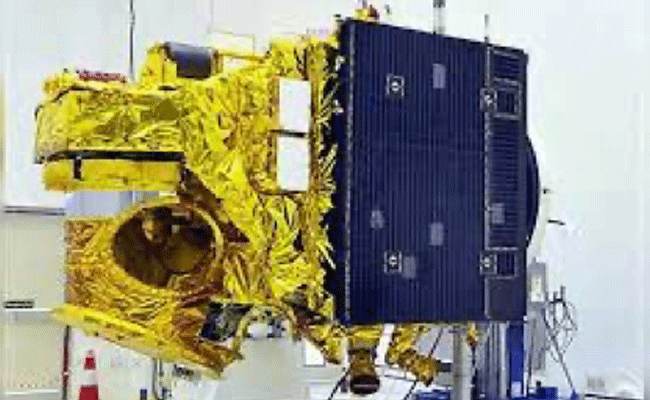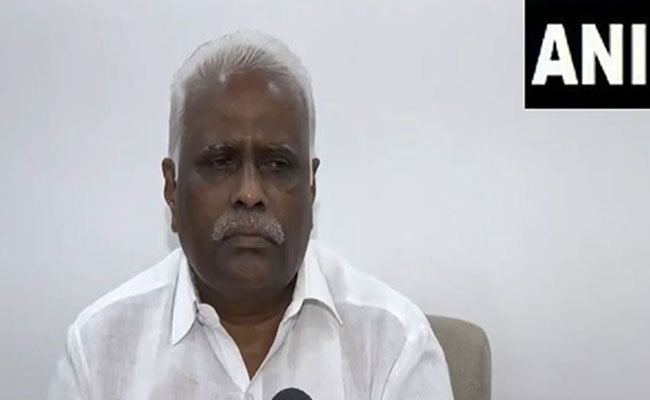Bengaluru (PTI): The Indian Space Research Organisation said it successfully carried out an "extremely challenging" controlled re-entry experiment of the decommissioned orbiting Megha-Tropiques-1 (MT-1) satellite.
"The satellite re-entered the Earth's atmosphere and would have disintegrated over the Pacific Ocean", the Bengaluru-headquartered national space agency said on Twitter on Tuesday.
The final impact region estimated is in the deep Pacific Ocean within the expected latitude and longitude boundaries, an ISRO statement said.
The low Earth satellite was launched on October 12, 2011, as a joint satellite venture of ISRO and the French space agency, CNES for tropical weather and climate studies.
Since August 2022, the satellite's perigee was progressively lowered through a series of 20 manoeuvres, spending about 120 kg of fuel.
Multiple manoeuvres including the final de-boost strategy were designed after taking into consideration several constraints, including visibility of the re-entry trace over ground stations, ground impact within the targeted zone, and allowable operating conditions of subsystems, especially the maximum deliverable thrust and the maximum firing duration constraint on thrusters.
All manoeuvre plans were screened to ensure that there would be no post manoeuvre close approaches with other space objects, especially with the crewed space stations like International Space Stations and the Chinese Space Station, ISRO said.
The final two de-boost burns were executed at 11:02 UTC and 12:51 UTC respectively on March 7 by firing four 11 Newton thrusters on-board the satellite for about 20 minutes each, it said.
The final perigee was estimated to be less than 80 km, indicating that the satellite would enter the denser layers of the Earth's atmosphere and subsequently undergo structural disintegration. The re-entry aero-thermal flux analysis confirmed that there would be no surviving large debris fragments.
The entire sequence of events was carried out from the Mission Operations Complex in ISTRAC (ISRO Telemetry, Tracking and Command Network), Bengaluru.
An uninhabited area in the Pacific Ocean between 5 S to 14 S latitude and 119 W to 100 W longitude was identified as the targeted re-entry zone for MT1, weighing about 1000 kg, ISRO said earlier this week.
About 125 kg on-board fuel remained unutilised at its end-of-mission that could pose risks for accidental break-up, an ISRO statement had noted.
This left-over fuel was estimated to be sufficient to achieve a fully controlled atmospheric re-entry to impact the uninhabited location in the Pacific Ocean, ISRO had said.
Controlled re-entries involve de-orbiting to very low altitudes to ensure impact occurs within a targeted safe zone.
Usually, large satellites/ rocket bodies, which are likely to survive aero-thermal fragmentation upon re-entry, are made to undergo controlled re-entry to limit ground casualty risk.
However, all such satellites are specifically designed to undergo controlled re-entry at end-of-life (EOL).
"MT-1 was not designed for EOL operations through controlled re-entry which made the entire exercise extremely challenging," ISRO said.
Furthermore, the on-board constraints of the aged satellite, where several systems had lost redundancy and showed degraded performance, and maintaining sub-systems under harsher environmental conditions at much lower than originally designed orbital altitude added to the operational complexities, it said.
Innovative workarounds were implemented by the operations team based on the study, deliberations, and exchanges among the mission, operations, flight dynamics, aerodynamics, propulsion, controls, navigation, thermal, and other sub-system design teams across the ISRO centres, who worked in synergy to surmount these challenges, it said.
Although the mission life of the satellite originally was three years, it continued to provide valuable data services for more than a decade supporting regional and global climate models till 2021, ISRO said.
UN/IADC (Inter-Agency Space Debris Coordination Committee) space debris mitigation guidelines recommend de-orbiting a LEO (Low Earth Orbit) object at its EOL, preferably through controlled re-entry to a safe impact zone, or by bringing it to an orbit where the orbital lifetime is less than 25 years, according to ISRO.
It is also recommended to carry out "passivation' of on-board energy sources to minimise the risk of any post-mission accidental break-up, ISRO said.
The orbital lifetime of MT-1 would have been more than 100 years in its 20 deg inclined operational orbit of 867 km altitude, it said.
"As a responsible space agency committed to safe and sustainable operations in outer space, ISRO proactively takes efforts for better compliance with the UN/IADC space debris mitigation guidelines on post-mission disposal of LEO objects", the ISRO statement said.
Let the Truth be known. If you read VB and like VB, please be a VB Supporter and Help us deliver the Truth to one and all.
New Delhi: In a striking turn that surprised even his regular viewers, Arnab Goswami spent the evening of December 4 taking direct aim at the central government over the ongoing crisis in the domestic aviation sector. The debate, aired on Republic, focused entirely on the severe disruption caused by IndiGo flight cancellations and the state of air travel in the country. The tone was sharp, emotional, and openly critical, raising the larger question of whether this marks a homecoming of sorts for the anchor long accused by critics of being soft on the government.
Goswami began the show by saying the central government had “completely let down” air passengers. He pointed to chaotic visuals from airports in Pune, Ahmedabad and Mumbai, describing passengers packed into crowded spaces, long queues, and travellers lying on the floor with little access to basic facilities. He said anyone travelling with children or elderly parents would understand the distress such situations cause.
According to him, the government often claims to have improved the aviation sector, but the day-to-day experience of passengers tells a different story. He argued that whatever help the government may have extended has benefited individuals and individual companies, not the sector as a whole.
Goswami highlighted data from the last three days, saying IndiGo had canceled 1,232 flights in November. He broke down the reasons for the cancellations: 755 linked to crew and FDTL constraints, 258 due to airspace and airport restrictions, 92 because of failures in air traffic control systems, 127 for other reasons.
He said passengers in India are often “taken for granted” and that only in this country can such large-scale cancellations take place without consequences.
Throughout the debate, Goswami repeatedly returned to the theme of duopoly. He said Air India and IndiGo together control 91.5 percent of the aviation market, leaving only a small share for others like Akasa and SpiceJet. This, he said, gives the two big players the power to decide prices and escape accountability.
“They can set the prices. They can torture passengers. They can be not answerable for air crashes.” He added.
Goswami also questioned why such a structure is allowed to exist if the government claims it opposes monopolies. He asked whether the government has made Air India accountable after the recent air crash, and said he did not believe so.
“We are told that the Modi government does not like monopolies. First of all, I don't agree with that. There are too many monopolies happening.” He said.
The anchor accused Air India of operating aircraft that were not airworthy and said no serious action followed. According to him, any other minister in charge of civil aviation would have been removed after such incidents, but nothing happened.
“He is not answerable. And why is the central government not bothered about it? Because he comes from the TDP, an alliance party. So let him do,” he said.
He added that Air India continues to seek government support, including compensation for losses after the Sindhur episode. Goswami questioned why public money should be used to support the airline, drawing a comparison with the earlier controversy involving Vijay Mallya seeking help from the Manmohan Singh government a move that was labelled as scam.
Goswami said passengers are suffering because of delayed flights, sudden cancellations, and lack of compensation. He criticised the DGCA, saying it was not enforcing safety and operational norms. He also questioned why the Prime Minister’s Office had not intervened.
He noted that Republic had carried multiple exposés on these issues and claimed that Air India chooses to give interviews and advertisements only to other channels.
He also called for Parliament to debate the aviation mess and examine whether monopolies or duopolies should be allowed in a nation of India’s size.
“I'm sure the government's not going to be happy with us saying this, but someone's got to speak up for the people of this country.” He added.
Known by his critics as the “Godi Media Chief”, Goswami’s direct attack on the Modi government over civil aviation raised eyebrows across media circles.
Whether this is a one-off outburst or a sign of a new editorial direction is something viewers will be watching closely.
#AviationCollapse | India’s aviation sector is in turmoil as IndiGo’s mass cancellations and Air India’s alleged safety lapses leave passengers stranded. The disruption raises serious questions about airline management, regulatory oversight, and who is ultimately responsible for… pic.twitter.com/Dqt6pcoW8w
— Republic (@republic) December 4, 2025





